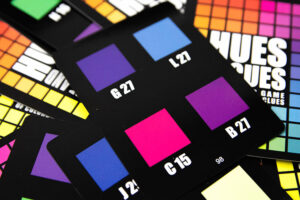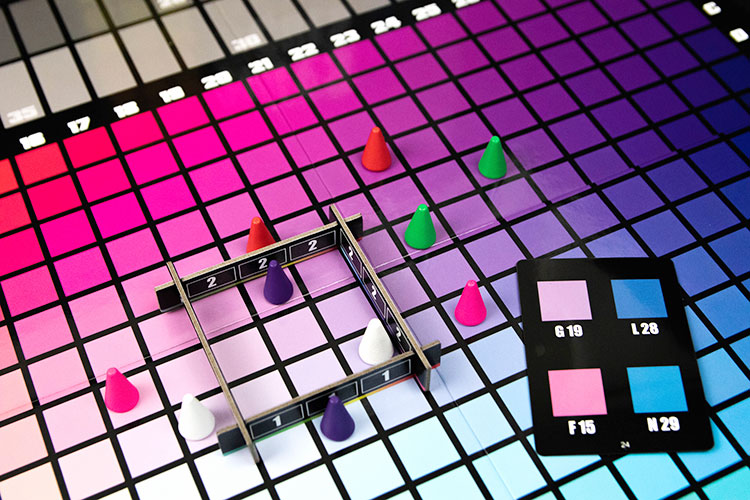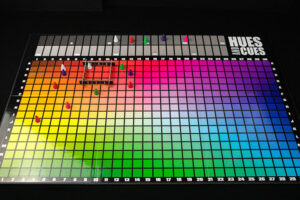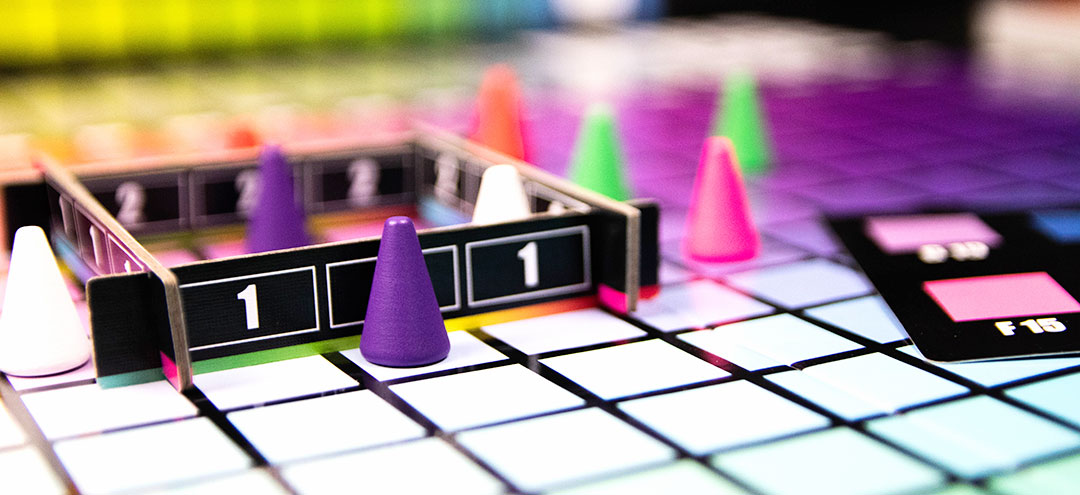 Party games kind of exist in a few different spheres. But one of the recently popular is the clue-giver and everyone else guesses style of games. Dixit is maybe the original where players try to describe the art on a card with a phrase of story. Codenames exploded onto the scene with its team-based vocabulary version.
Party games kind of exist in a few different spheres. But one of the recently popular is the clue-giver and everyone else guesses style of games. Dixit is maybe the original where players try to describe the art on a card with a phrase of story. Codenames exploded onto the scene with its team-based vocabulary version.
Hues and Cues takes a similar approach but to the more mundane (perhaps) activity of describing colors. So let’s dive into how it works and see if it should be something you break out at your next get together (in 2022 or so…).
Gameplay Overview:

In a round of Hues and Cues, the clue-giver will draw a card—giving them a color that they want to try to get everyone else at the table to guess. You’ll start by giving a one-word clue. Then everyone will place their pawns on the color they think represents the word you said.
Of course, you can’t just say “green.” First off… that is a terrible clue. There are like 20 different shades of green on the board. Also, the rules specifically disallow color words. You also can’t describe something in the room that people can see. It’s got to be more like a feeling. “Herbaceous,” maybe. Or “dusty.”
After everyone has guessed, you can give an additional clue. This one up to two words, to allow people to refine their guesses. You’ll then place the included box on the board so that your target color is in the center. Everyone who is in, or near, the box will score points. The clue giver scores points based on the number of people who were in the scoring box as well.

Game Experience:
Hues and Cues exists firmly in the same world as a game like Dixit. It’s easy to jump in and play. It’s also easy to learn and accommodates a huge number of players. But for me, Dixit requires more of a storytelling brain. You have to interpret a picture and you can choose to give a short clue but you can open it up to a whole paragraph if you want.

Hues and Cues, on the other hand, triggers a more analytical part of my brain. How can I describe how this light shade of pink feels? It’s a bit Codenames-like in how it opens up to really allow some very clever clue giving. I’m sure there are more artistic minded folks that might see Hues and Cues as a more creative outlet (or even a test of color theory or something).
I think, generally, Hues and Cues will appeal to people who love Dixit and Codenames both. Even if the description may not obviously be a mashup of the two, I think it lands firmly in the middle of the experiences those games evoke. And a clue/guessing party game that can appeal to both the analysts and artists alike is pretty unique.
That said, there are a lot of similar shades on this board. To be exact—480 different colored squares. Trying to tell minty green from slightly minty-er green is pretty difficult. Of course, the scoring frame means you’ll get points for being just in the neighborhood, but it can feel a little bit like shooting in the dark. Of course, that’s also what makes the game rewarding when you come up with a clue that just nails it for everyone.
Final Thoughts:
Look, Hues and Cues isn’t revolutionizing party games here. It’s a riff on a familiar formula for sure. But there is a lot to be said for a game that has wide appeal and can be taught in just a couple of minutes. It’s a great game to break out on the 4th of July when everyone is just having some drinks and not looking to rack their brain on a crunchy euro.
I think it appeals to a larger group of gamers than the more creative-focuses Dixit and the very dry and slow-paced Codenames. And if you like either, or both, of those games you should definitely give Hues and Cues a look.
Final Score: 4 Stars – A great party game for artists and scientists alike.
 Hits:
Hits:
• Easy to learn and teach party game, perfect for a low-stress game day.
• Giving the perfect clue to describe exactly the shade you are aiming for can feel especially rewarding.
Misses:
• Some colors just feel very difficult to differentiate from all the other shades.
• It’s similar to many games you may already have on your shelf.























